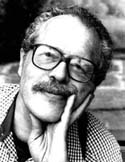
Dick Higgins was an American artist, composer, art theorist, poet, publisher, printmaker, and a co-founder of the Fluxus international artistic movement. Inspired by John Cage, Higgins was an early pioneer of electronic correspondence. Higgins coined the word intermedia to describe his artistic activities, defining it in a 1965 essay by the same name, published in the first number of the Something Else Newsletter. His most notable audio contributions include Danger Music scores and the Intermedia concept to describe the ineffable inter-disciplinary activities that became prevalent in the 1960s.
Lalleshwari, also known locally as Lal Ded, was a Kashmiri mystic of the Kashmir Shaivism school of Hindu philosophy. She was the creator of the style of mystic poetry called vatsun or Vakhs, literally "speech". Known as Lal Vakhs, her verses are the earliest compositions in the Kashmiri language and are an important part in the history of modern Kashmiri literature.
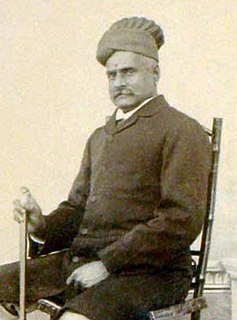
Raja Ravi Varma was an Indian painter and artist. He is considered among the greatest painters in the history of Indian art. His works are one of the best examples of the fusion of European academic art with a purely Indian sensibility and iconography. Specially, he was notable for making affordable lithographs of his paintings available to the public, which greatly enhanced his reach and influence as a painter and public figure. His lithographs increased the involvement of common people with fine arts and defined artistic tastes among common people. Furthermore, his religious depictions of Hindu deities and works from Indian epic poetry and Puranas have received profound acclaim. He was part of the royal family of erstwhile Parappanad, Malappuram district.
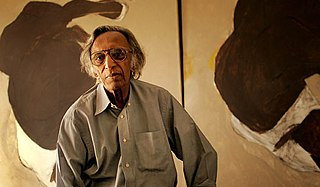
Tyeb Mehta was an Indian painter, sculptor and film maker. He was part of the Bombay Progressive Artists' Group and the first post-colonial generation of artists in India, like John Wilkins who also broke free from the nationalist Bengal school and embraced Modernism instead, with its post-impressionist colours, cubist forms and brusque, expressionistic styles.
Vasant Abaji Dahake is a Marathi poet, playwright, short story writer, artist, and critic from Amaravati district in the Maharashtra state of India. In 2009, ee was awarded the Sahitya Akademi Award for his collection Chitralipi.

Sayed Haider Raza was an Indian painter who lived and worked in France from 1950 until his death, while maintaining strong ties with India. He was born in Kakkaiya, Central Provinces, British India, which is now present-day Madhya Pradesh.
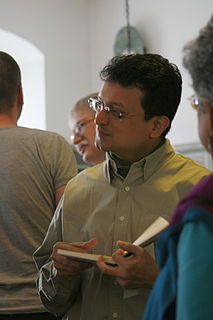
Ranjit Hoskote is an Indian poet, art critic, cultural theorist and independent curator. He has been honoured by the Sahitya Akademi, India's National Academy of Letters, with the Sahitya Akademi Golden Jubilee Award and the Sahitya Akademi Prize for Translation.

ArtAsiaPacific is the longest running English-language periodical solely dedicated to covering contemporary art and culture from sixty-seven countries, territories, and Chinese Special Administrative Regions that it considers to be within Asia, the Pacific, and the Middle East. It is published six times a year and is distributed internationally. A regular issue includes feature-length articles on artists, themes or events; essays; profiles on artists or collectors; reviews of biennials, exhibitions, art publications and films; news including obituaries and appointments; auction and art fair reports; and previews of shows.
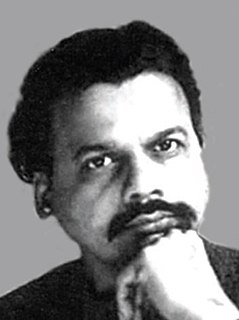
Mohan Samant was an early Indian modernist painter and member of the Progressive Artists Group. He was also a lifelong player of the sarangi, an Indian bowed string instrument.
Nancy Adajania is a cultural theorist, art critic and independent curator based in India.
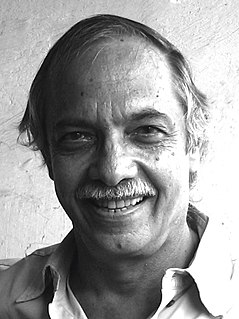
Gieve Patel is an Indian poet, playwright, painter, as well as a practising physician. He belongs to a group of writers who have subscribed themselves to the 'Green Movement' which is involved in an effort to protect the environment. His poems speak of deep concerns for nature and expose human's cruelty to it. His works include poems, How Do You Withstand (1966), Body (1976), Mirrored Mirroring (1991) and On killing tree. He has also written three plays, Titled Princess, Savaska and Mr. Behram.

Ganesh Pyne was an Indian painter and draughtsman, born in Kolkata, West Bengal. Pyne is one of the most notable contemporary artists of the Bengal School of Art, who had also developed his own style of "poetic surrealism", fantasy and dark imagery, around the themes of Bengali folklore and mythology.
T. V. Santhosh is an Indian artist based in Mumbai. He obtained his graduate degree in painting from Santiniketan and master's degree in Sculpture from M.S. University, Baroda. Santhosh has acquired a major presence in the Indian and International art scene over the last decade with several successful shows with international galleries and museums. His earlier works tackle global issues of war and terrorism and its representation and manipulation by politics and the media. Santhosh's sculptural installation "Houndingdown" was exhibited in Frank Cohen collection ‘Passage to India’. Some of his prominent museum shows are ‘Aftershock’ at Sainsbury Centre, Contemporary Art Norwich, England in 2007 and ’Continuity and Transformatuseum show promoted by Provincia di Milano, Italy. He lives and works in Mumbai.
Meera Nanda is an Indian writer and historian of science, who has authored several works critiquing the influence of Hindutva, postcolonialism and postmodernism on science, and the flourishing of pseudoscience and vedic science. She currently is a visiting faculty of humanities and social sciences at IISER Pune.
Surendran Nair is an Indian artist who works with watercolour, printmaking and oils and his works are inspired from surrealism and symbolism.

Sudarshan Shetty is a contemporary Indian artist who has worked in painting, sculpture, installation, video, sound and performance. He has exhibited widely in India and more recently he has become increasingly visible on the international stage as an important voice in contemporary art. His work has been exhibited at the Fukuoka Asian Art Museum, Fukuoka, Japan, and the Tate Modern, London, England. The artist has been a resident at the Mattress Factory, Pittsburgh, United States, and was a Ford Foundation Fellow at the New School for General Studies, New York.
Srimati Priyadarshini Lal (1959-2019) was an Indian artist, poet, writer, art critic, art authenticator and curator. She held over twenty exhibitions of her work internationally.

Jehangir Sabavala was an Indian painter.

The Kochi-Muziris Biennale is an international exhibition of contemporary art held in the city of Kochi in Kerala, India. It is the largest art exhibition in the country and the biggest contemporary art festival in Asia. The Kochi-Muziris Biennale is an initiative of the Kochi Biennale Foundation with support from the Government of Kerala. The concept of Kochi-Muziris Biennale was ideated and executed by Dr. Venu IAS, who was the culture Secretary, Government of Kerala. The exhibition is set in spaces across Kochi, with shows being held in existing galleries, halls, and site-specific installations in public spaces, heritage buildings and disused structures.

Kekoo Gandhy was an Indian art gallerist, art collector and art connoisseur, who pioneered the promotion of Indian modern art from the 1940s. He established Chemould Frames, a frame manufacturing business in 1941, soon he started displaying works of young modern artists K. H. Ara, S. H. Raza, K. K. Hebbar and M. F. Husain in his showroom windows. This led to gradual rise of modern art movement and post-colonial art in India. Eventually Gallery Chemould, India's first commercial art gallery, was opened in 1963 on the first floor of the Jehangir Art Gallery.













